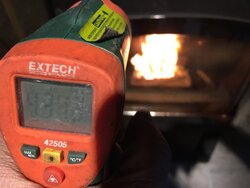woodmakesheat
Feeling the Heat
Based on the laser it's reading the front of the stove near the top of the firebox.
So to answer the O/P, the air exiting the vents (stove on high, 260 CFM blower on high) is 210F. Now if I stick the thermocouple between the gasket and metal at top of door (best I can before I burn my flesh off), it read 430F.
So to answer the O/P, the air exiting the vents (stove on high, 260 CFM blower on high) is 210F. Now if I stick the thermocouple between the gasket and metal at top of door (best I can before I burn my flesh off), it read 430F.





